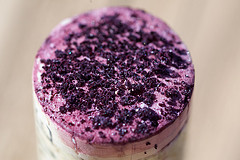 On 15th March, the Museum of the History of Science in Broad Street, Oxford hosted a ‘Crystals Day’ as part of their long-running crystals exhibition in the museum basement gallery.
On 15th March, the Museum of the History of Science in Broad Street, Oxford hosted a ‘Crystals Day’ as part of their long-running crystals exhibition in the museum basement gallery.
Hands-on activities were run by Diamond Light Source (including their lego beamline), volunteers from the Solar Fuels outreach team from Chemistry and live crystal growing expertly run by Jonny Brooks-Bartlett and Katharina Jungnickel, graduate students in Biochemistry.
Their were also four 30-minute ‘popup’ talks in the basement gallery from Brian Sutton (King’s College London) on crystal symmetry and diffraction; a tale of persistence to overcome ‘Mission Impossible’ – growing some virus protein crystals by Elspeth Garman (Biochemistry); Pasteur, Penicillin and Point Groups by Richard Cooper (Chemistry) and Dorothy Hodgkin: A life by Georgina Ferry, Dorothy’s biographer.
